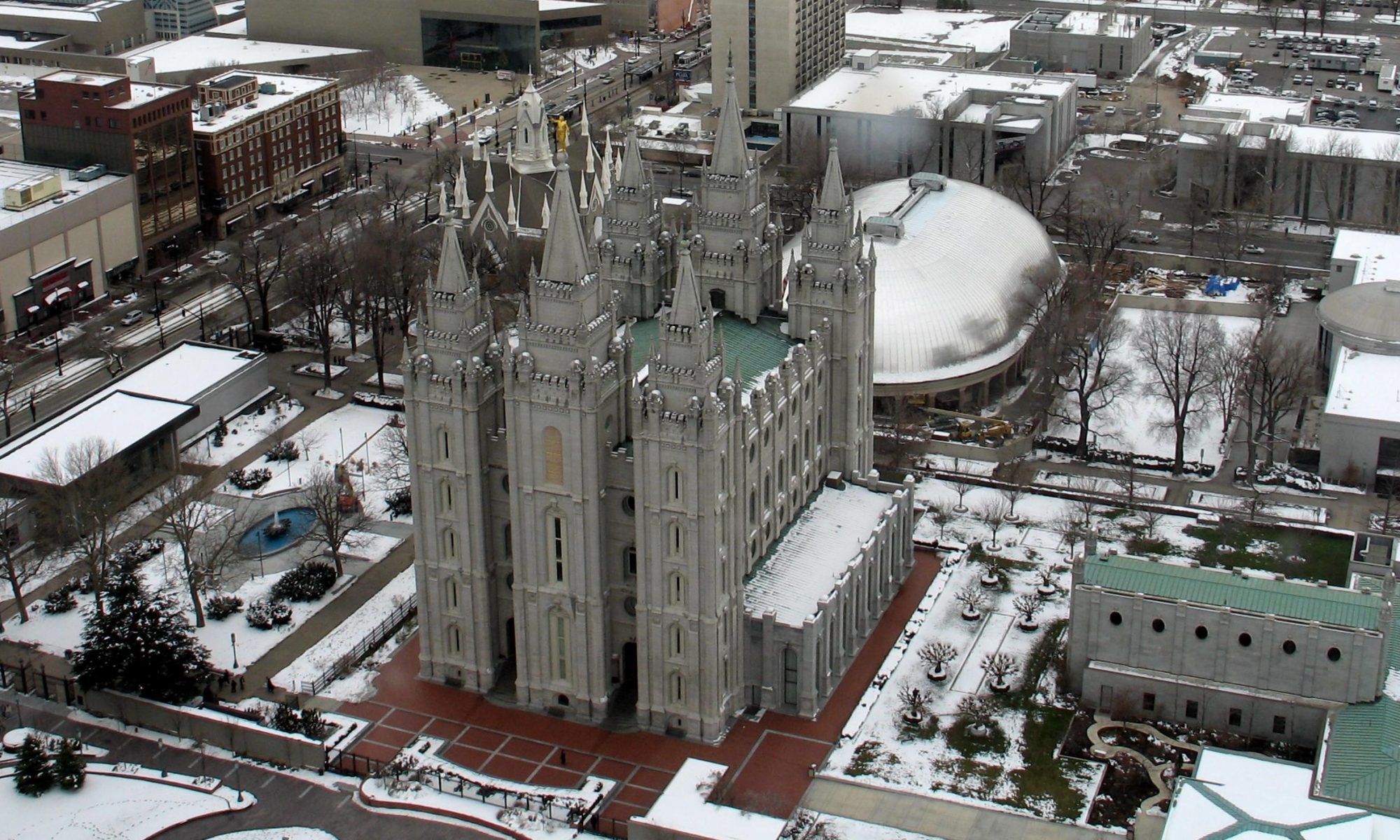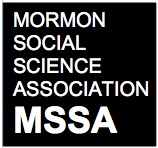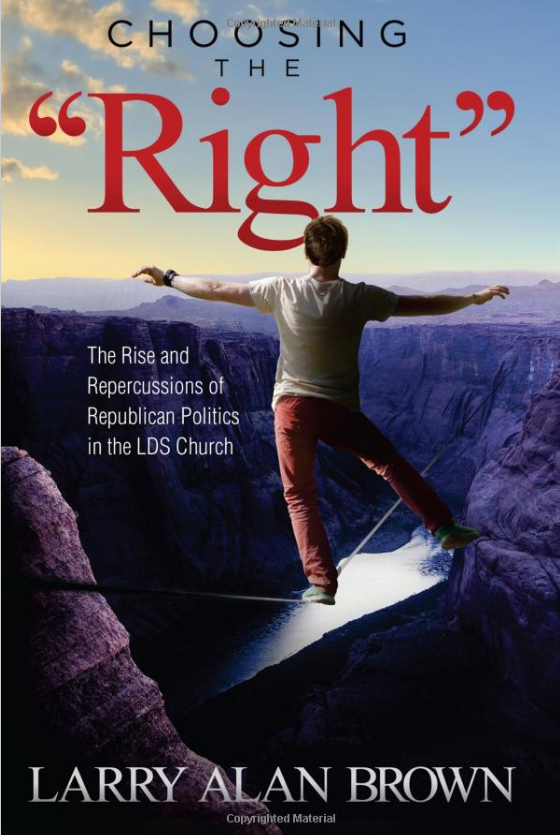Choosing The “Right” ties together opinion polls, newspaper articles, and a vast array of the author’s personal experiences as a Mormon Democrat in Utah to provide a general introduction to what he convincingly portrays as a serious problem: “A preponderance of LDS Republicans believe that their choice to live a gospel life is synonymous with choosing to support a Republican political ideology” (xi-xii). After a brief, 11-page overview of the historical rise of Republican politics in the LDS Church, Brown begins to make the case, aptly citing Putnam and Campbell’s Mormon interview results from their book American Grace, that the identity label “Mormon Democrat” has become a culturally unquestioned oxymoron.
Brown is most successful at elucidating this oxymoron when he cites documented personal experiences, his own or those of others, to open an intimate window into the confusion and damage caused by Mormon prejudice towards Democrats in contemporary Utah. Chapters 3 and 4, “Can a Democrat Be a Good Mormon?” and “Alienation in the Church,” are ethnographic gems that include everything from high-ranked local church authorities deriding Obama voters from the pulpit to laity poking fun at Democrats as if doing so were an ecclesiastical norm. This last hearkens back to a poignant story in the introduction wherein the author, assumed by his coreligionists to be a fellow Republican, storms out of a Sunday worship service that has degenerated into a Democrat-bashing contest.
Having substantiated his claim that US Mormons often conflate the GOP with gospel worthiness and the Democratic party with unworthiness, Brown, in the last section of the book, elaborates on some of the indirect repercussions of these conflations. Though he does not delineate his logic explicitly, he seems to be arguing that since a majority of US Mormons think God expects them to vote Republican, and since Mormons are a majority in the state of Utah, Utah has become a state of one-party rule. He then skillfully demonstrates, in Chapter 11, how one-party rule puts unchallenged power into the hands of an increasingly unrepresentative few. This undermines healthy democratic processes in Utah as like-minded elites legislate in secret while fully expecting the public to trust they are ethical simply because they are Mormon. Chapter 11 provides an incisive examination of how unethical these Mormon government representatives can be in the state of Utah and the brazen efforts they make to keep the public uninformed about their actions.
After reading Chapter 11, I began to wonder: Is Brown really open to the possibility that one-party rule could be equally disastrous in the hands of either major US party? He seems to claim as much, yet the thrust of the book contradicts his claim and confuses the reader as to his true purpose. On the one hand, Brown appears to be saying that the danger to the LDS Church lies in its being perceived as beholden to one party over the other in the US two-party system regardless of what that one party may stand for. He even goes so far as to write that God himself “does not favor one political party or philosophy over another” (18). On the other hand, he describes in exhaustive detail in chapters 5-9 the precise mechanisms through which Republican ideology has made the poor poorer through trickledown economics and its mantra that private charities can do a better job than government safety nets. He further demonstrates in chapter 10 (The Lean and Mean Republican Government) that it is not the LDS connection to just any party that has made Utah into a mismanaged state full of suffering and poverty; it is its connection to the GOP. These arguments lead to a logical quandary. If Brown is able to simultaneously believe that (1) God has no party preference and (2) that the contemporary Republican party is largely responsible for the poverty experienced by thousands of people in the US, the logical conclusion is that he must think God does not care about the poor, else God would not let Republicans further impoverish the poor. Since it is obvious that Brown does not believe that God does not care about the poor, the book would be substantially improved if he boldly owned the conclusion that logically stems from his arguments: It is morally indefensible for a Christian who wants to alleviate poverty to vote Republican today. Brown should either make this claim from the outset (at the risk of alienating his Republican readership) or eliminate the six middle chapters designed to show that Democrats are better at resolving poverty than Republicans and replace these chapters with six that get back to the subtitle’s promise to delve into “The Rise and Repercussions of Republican Politics in the LDS Church.”
Brown does eventually come back to the “repercussions” half of this promise in an excellent section titled “Unauthorized Immigration” (pp. 184-196). This section offers a careful portrayal of how the cultural assumption under focus—to be Republican is to be a good Mormon—led Mormons in Utah and Arizona to automatically adopt an anti-immigration stance simply because the national Republican party adopted that stance as part of the politically expedient bundle of issues it used to define itself at that point in time. The deeply ironic (given the LDS Church’s own migration history) and hypocritical nature of this stance forced the LDS Church leadership to make a statement they considered to be middle-of-the-road, encouraging compassion towards unauthorized immigrants while placating their largest group of constituents (Republicans) by claiming that the US government is somehow justified in keeping immigrants out. Though this section is informative, one is still left with the nagging question, How are Mormons in the US so incredibly Republican that they would ignore some of the core teachings of the person whose name appears in bold print on their logo (e.g., “I was a stranger, and ye took me in”) before they would ignore national party leaders? Choosing the “Right” offers only a glimmer of an answer to this complex question in its short attempt at fulfilling the “rise” half the subtitle’s promise. Even so, one comes away hopeful that in a future endeavor, Brown will expand on his 11-page historical teaser and answer questions similar to the following:
How has the co-evolution of US-expansionism and the Mormons’ own Manifest Destiny in Utah influenced Mormon politics? How have the Mormons’ early use of theocracy and current use of divine calling (rather than elections) affected the membership’s expectations of representative government? How has the US-exceptionalism enshrined in Mormon holy books (replete with declarations such as those implying that Christopher Columbus was inspired by the Holy Ghost, that the US-perpetrated genocide of Native Americans was justified, and that the US Constitution is a divine document) affected the membership’s loyalty to the Republican party and the Church’s relationship to the rest of the world? How has the Republican party changed over time and how have Republicanism and Mormonism shaped each other? From the beginning of the church until the present time, in what ways are specific Church leaders (other than Ezra Benson) to blame for the continued assumption among Utah Mormons that choosing the “left” is morally wrong? How have Mormons historically separated what is political from what is moral or spiritual? How have individual Mormons historically and currently justified, in speech or writing, their choice to vote for one candidate or another?
Jason Palmer
PhD Candidate in Anthropology at The University of California Irvine


